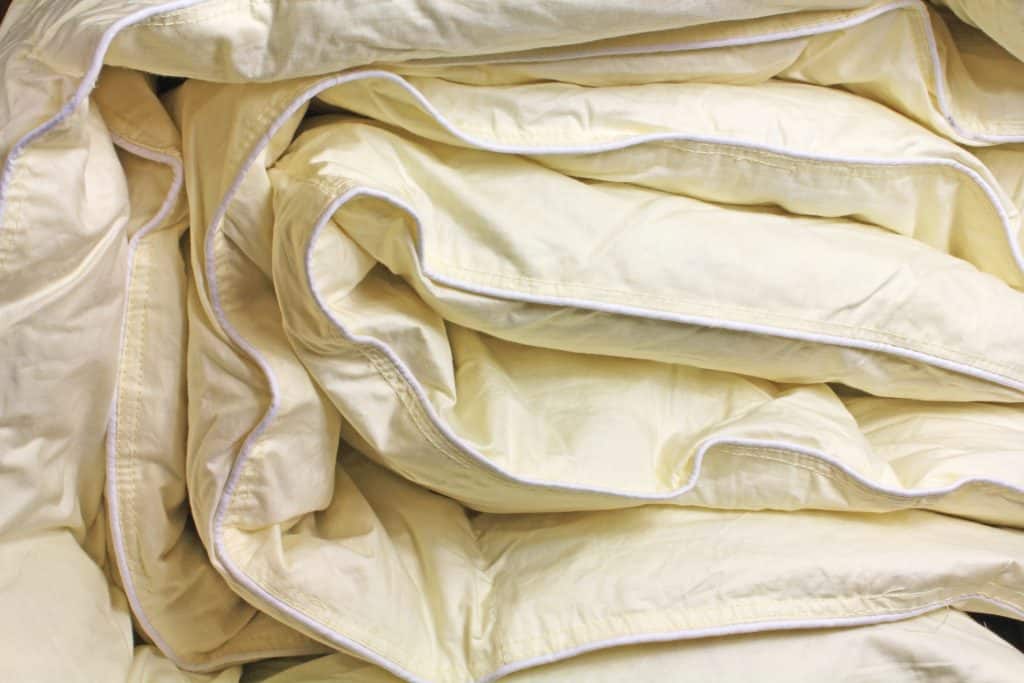Duvets
What Is a Duvet?
Duvet is the French word for a soft flat bag filled with down. The flat bag can be filled with soft materials such as down, feathers, silk, wool or any type of synthetic alternatives. Duvets are oftentimes used as a top layer of bedding to provide warmth and comfort for the sleeper. A removable duvet cover is used to protect your duvet. This is much the same as covering your pillow with a pillowcase. Since the duvet cover can be removed, it can be easily washed.
Originally, duvets were used in rural Europe. People would fill their duvets with feathers, dried leaves or straw. However, the most effective thermal insulator is the down that comes from eider ducks. Typically, duvets are white, so they are not visible through the duvet cover.
Duvet Cover
A duvet cover is used for protecting the duvet. With a duvet cover, you can easily change the appearance of your bedding, just like a pillowcase for your pillow. Duvet covers can be easily laundered and stored.
Some people don’t use a top sheet anymore since the duvet cover can also be used as a sheet. This is common in Europe.
Duvets vs Comforters
Some people think that duvets and comforters are the same. Specifically, in the U.S. they often interchange these two terms. The differences between duvets and comforters are subtle.
In some dictionaries, the word comforter is used as a synonym for duvet. But the fact is, they are not the same. They are two different types of bedding.
Duvets can provide warmth and comfort, yet surprisingly they are also lightweight. Most duvets have a white or off-white colour. It is cheaper and easier to change the look and style of your bedding by using a duvet cover. There’s no need to launder the duvet often; all you have to do is wash the duvet cover frequently. If you want something fluffier, then you should go for duvets rather than comforters.
On the other hand, comforters are flatter, hence you must layer them with blankets, especially during the winter season. Since it does not have a protective cover, it is a must to wash them regularly. If you want to change the look and style of your bedding, then you have to change the comforter because it has no cover. A comforter is a good option for people who don’t want to use a separate cover.
So, which is better: a duvet or a comforter? Some people prefer duvets because they can easily change the style of their bedding and they don’t have to wash their duvets more often because it has a cover. But for others who are looking for simplicity, then the best choice for them are comforters.
When choosing your bedding, be sure to consider your lifestyle and what works best for you and your home. This way, you can never go wrong.
How to Choose a Duvet?
Choosing a duvet can be a confusing and intimidating task since every manufacturer wants their product to shine above the rest without adding any costs. They would rather concentrate on selling you their product based on the specification.
However, if you want to get the best value for your money, then make sure it can provide the comfort you need for a better night’s sleep. You should consider several factors before buying.
Choosing Your Comfort Level

Determine your comfort level, there are three seasonal duvets you can generally choose from. They are summer, winter and all-season duvets. Each of these differs in its filling weight which is measured by down per square metre. This means that the heavier the fill weight, the warmer the duvet. Yes, a heavier fill weight means more warmth.
If you prefer to sleep in a warmer environment, then a heavier fill can make you feel more comfortable. However, if a cooler atmosphere makes you feel cosier, then you should go for a lighter fill.
Determining the Quality
After settling on the comfort level, the next thing to do is to choose the quality of the material.
First, you need to determine its loft. Keep in mind that the higher the loft, the higher the percentage of the down clusters. This is a sign of durability. The thread count is also another factor to consider. The higher the thread count, the smoother its finish. This can improve your sleep experience.
Duvet Fillings
A duvet can either be filled with natural or synthetic fillings. For people who suffer from allergies, the best option is a synthetic duvet. Otherwise, a natural duvet is lighter and warmer.
Natural Fillings vs Synthetic Fillings
Duvets that use natural fillings are softer. Usually, they are filled with down or feathers from ducks or geese.

Synthetic Fillings
Synthetic duvets are hypoallergenic. This means that they are the best option for people who are allergic to feathers or down. Duvets with synthetic fillings can be washed more often than natural fillings.
How is a Duvet Constructed?
Technically, there are two ways of making duvets, either by using the box stitch or the baffle box method. For the box stitch method, the duvet is sewn together to form several small boxes. Then, each of these boxes is filled with an equal amount of natural filling or synthetic filling. This means that there are no cold spots since they are evenly distributed all over the duvet.
Baffle boxes are much the same, but instead of boxes, cubes are created. Cubes are constructed by sewing additional fabric between the top and bottom layers. This is done to add more volume to the structure. Most often, this is used in duvets with higher togs.

